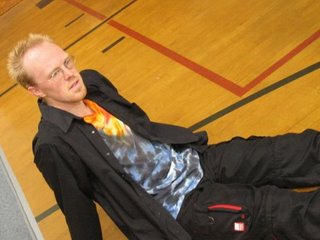
What did I learn at Rhythmic Arts 2007? Two things:
Occasionally I'll be dancing with a very decent follow, and things will be going well... And sometimes, (often enough to start making me suspicious), I'll lead something a bit unusual, and the follow will say,
I'm sorry, I don't know what you're leading. Now normally a lead might take that as a signal that they're not leading very clearly.... I've always discounted these statements because in every case I've experienced, the follows have been correctly following whatever unusual move I was leading even up to the moment when they stop to express their confusion.
You were just following it flawlessly-- how can you be confused?! I almost want to scream. But I tried leading more strongly this weekend (the difference being that this time I tried it with light follows that I trusted), and it seemed to work well. Now I'm excited to experiment with strong vs weak leads. Or rather, to find the trade-off between liquidity and clarity. Maybe it's just a signal that I haven't been leading very clearly :D
It
is possible to take dancing for granted. This weekend, I did a much better job at balancing my dance time with my rest time than I've done in the past. I felt like I was almost continuously dancing the entire weekend-- I wasn't worn out two hours in to the night, and I wasn't sitting in the corner. By Sunday night, my body reached a state of proficiency that I haven't felt since ALX05. I've been to quite a few events since then, but I've basically wasted them. This weekend I've realized that I really need to put a lot of energy into dancing when I go to events, otherwise I may just as well go to San Diego venues, or dance in my bathtub. And I mean A LOT of energy! Remember how exciting it is to dance in a new place?! with new people?! with hundreds of new people from places of the country that you've never danced in?! to some of the best live music in the country?! for hours and hours on end?! having an entire weekend to find your groove, find the music, and just
live lindy hop?! That's what an exchange is, and don't forget it!
That's it-- those are the two things.
Also, I took some good video clips, but better than that, I got two priceless mental images: the arch of Debbie Gitt's back (more on that later), and Andy Stockdale LHAO at Peter Loggins in the blues finals--
See you all next year!


